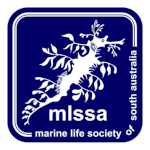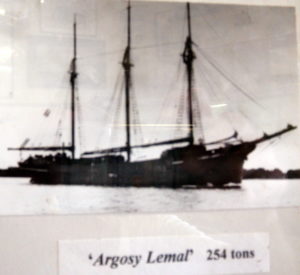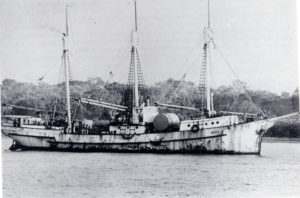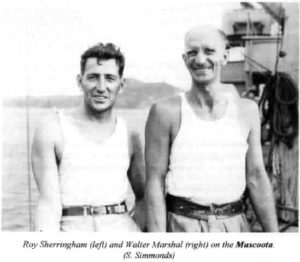I had previously written a series of articles regarding a number of sailing ships, but two in particular – the Booya and the Lemael.
The series started with “Cyclone Tracy Shipwrecks” in our April 2005 newsletter (No.320). This was followed by “More About the Booya” in our July 2005 newsletter (No.323). The third article was titled “The Wreck of the Schooner Lemael” and it was published in our June 2007 newsletter (No.344). The final one in the series (until now) was “The Schooner BOOYA 4.0” in our January 2008 newsletter (No.350).
Throughout some of these articles, some confusion between two ships– the Lemael and the Argosy Lemal (later the Booya) – was discussed.
As I wrote in my article “The Wreck of the Schooner Lemael”, published in our June 2007 newsletter (No.344), there has been much confusion regarding the schooner Lemael and her final days.
The schooner Argosy Lemal
(A 3-masted schooner similar to the Lemael)
(Source: http://www.dsac.com.au/Divesite_files/Booya.htm )
We recently received an email message as follows: –
“Greetings, I have just finished re-writing my father’s account of the wreck of the Lemael, he was a crew member. During my research on Trove I came across some archived material which mentioned the ship. The article was in a Newsletter from your Society, No. 323 dated July 2005, written by Steve Reynolds.
I won’t bore you at this stage, but if you want the record corrected please feel free to contact me and I can supply you with all the information.
Kind regards, Sue Simmonds, ABERDARE NSW. 2325”
I told Sue that I would love to hear about her father & the ship. Her response was: –
“Hi Steve, the photo referred to in the Newsletter was the Lemael, she was aground in 1901 off Largs Bay. The Lemael had (a) sorry history of accidents, incidents, etc,. and I’m sure if my Dad had known her history he may not have set foot on her.
The Argosy Lemal was only built in 1917 in the Netherlands, and only carried that name from 1920, but the archived photos of her show a schooner rigged three-masted vessel which would have been easy to confuse with the Lemael.
Dad, Walter Rignold Marshall, was born at Nhill, Vic., in 1901, He went to live at Port Adelaide in 1909, and all his family were South Australians, his grandparents having arrived in the colony in 1852 and settling, after brief stints in Adelaide and Robe, finally at Naracoorte, where they are buried along with his father. Dad went to sea in 1916.
Dad joined the Lemael, in Adelaide, around April 1921, but sustained an injury in Launceston while unloading the cargo, and eventually contracted diphtheria and was unable to return to Port Adelaide with the ship. However, when the ship returned to Launceston, he was re-signed and prepared for the return to Port Adelaide.
The voyage was eventful, the ship taking water, beset by overcast weather, which made taking a sighting of their position impossible, but eventually they sighted the Cape Otway light, and by this time, battling a westerly wind, ran for Port Phillip Bay. They rounded up at Point Nepean, Portsea, and there lost an anchor when it dragged and parted. From a historical point of view, that anchor should still be on the bottom somewhere off Portsea. After three days, they had favourable winds and were able to leave Port Phillip Bay and headed to Port Adelaide. The weather turned but they sighted the Cape Jaffa light and were satisfied that they had plenty of sea room, but sometime later, when sighting the light at Cape Banks, they were again satisfied that they had plenty of sea room. Dad had just gone off watch and had only just gone to sleep when he was called on deck, they were in the breakers.
Suffice to say, the ship was wrecked close inshore, but they spent a rather nasty night clinging to the rigging, dodging falling masts and loose deck cargo, timber for the South Australian Railways. They were finally washed overboard, fearing the worst, but finding that they were in shallow water. The Lemael had been picked up by a wave and carried over the reef and finally started to break up close to the beach. That was July 1921. He was rescued from the beach and when he and his crew mates, all were saved, had recuperated, five went to Melbourne, and three, including Dad and Captain Holyman, went to Adelaide. The good citizens of Millicent, had rendered assistance and saved the life of the crew.
I have a more precise account of the wreck that Dad left if you would like me to send that to you. I’m keenly interested in history and am always pleased to see it archived. I have the original Discharge paper from the Lemael which, when you think about it, is weird. He signed on on the 7/06/1921 and was discharged on the 1/08/1921.
Hope you find this interesting. Cheers, Sue Simmonds”
I told Sue, “I’ve done some reviewing of my articles and would definitely like
to see that ‘more precise account of the wreck that Dad left you’ please.” The information that ultimately came from Sue has helped me to determine:
The exact number of masts
The real builder
The true tonnage
The exact number of crew
The exact date of the wrecking (year & exact date)
Sue has provided me with her father’s account of the final days of the Lemael. Walter Marshall was an able seaman on her when she became wrecked near Cape Banks, SA in July 1921. Walter wrote an unpublished manuscript titled “The Gypsy Seafarer” which included a section about the wreck of the Lemael. Details provided in this section reveal that the vessel had three masts, was built by a Mr George Lee (rather than E.Hicks), was of 298 tons (rather than 98 tons), had a full complement of eight men (rather than a crew of seven) and became wrecked in July 1921 (possibly 31st).
According to Walter Marshall’s manuscript, he was an able seaman on the Lemael in 1921. The manuscript states, “She was a 3-masted schooner”. It goes on to state, “The Lemael was a wooden vessel of 298 tons register”. This tonnage is confirmed on Walter’s certificate of discharge. His manuscript also states that the Lemael was “built at the Duck River in 1892 by My George Lee of Smithton, Tasmania” and “her full complement was eight men”. Although the manuscript does not give a date for the wrecking of the Lemael, it clearly occurred in July 1921, probably after 21st July, possibly on 31st July.
A “Wreck Report for ‘Lemael’, 1901” can be found at http://www.plimsoll.org/resources/SCCLibraries/WreckReports/18187.asp . This report is about “the stranding of the schooner “LEMAEL,” which occurred at Largs Bay on the morning of Monday, 17th June, 1901”.
The report states, “The “Lemael” is a British schooner of 112 tons register, built of wood, owned by Mr. George Lee, of Buck River, Tasmania. . . official number 79,300”.
So, although the Lemael was reportedly 98 tons when built in 1892, she was said to be 112 tons in 1901. The tonnage stated on Walter Marshall’s 1921 certificate of discharge appears to read 298 tons, and this alone could be the source of Walter’s details.
There doesn’t appear to be a Buck River in Tasmania, only a Duck River, so the mention of Buck River in the “Wreck Report for ‘Lemael’, 1901” appears to be an error.
“Ketches of South Australia” by Ronald Parsons gives the Lemael (O/N 79300) as having 2 masts, being 98 tons, built at Duck River and being wrecked on 21st July 1921.
“South Australian Shipwrecks” by Peter Christopher gives Lemael as having 3 masts and being 98 tons, but wrecked on 31st July 1921.
I am tempted to suggest that Walter Marshall’s reading of the tonnage of 298 tons on his certificate of discharge is an error, simply because the ‘2’ is fainter than the rest of the ‘298’. It may well be that the ‘2’ is actually something else altogether, or it only shows there in error. 298 tons would make the Lemael bigger than the Booya, something that seems to be unlikely given the stated dimensions of the two vessels. There isn’t much difference between the two vessels however. The Booya was apparently a bigger vessel than the Lemael, and she was said to be 256 to 262 gross tons. Tonnage and gross tons is, however, somewhat involved. Check out Wikipedia at https://en.wikipedia.org/wiki/Tonnage for more details.
Sue later sent me the following details:
“Just on the”Argosy Lemal”. She was built in the Netherlands in 1917 and named the “Booya” the name was changed to the “Argosy Lemal” in 1920 and after a couple of more name changes was changed back to “Booya” in 1964 before being lost in Darwin Harbour in 1974 during Cyclone Tracy.
Why I had some knowledge of the “Argosy Lemal” was because she was requisitioned by the US. Army Transportation Corps, “small ships” during WW11, and used as a radio ship. My dad served in “small ships” with the Americans during WW11, and was in Milne Bay, etc.. for a two-and-a-half-year period. He left diaries of the period, written at the time, so they are accurate. Because of his nearly twenty years at sea before WW11, he knew many of the ships requisitioned by the US Army, and despite the fact that they had a numerical designation, he knew their names, and wrote them down in the diaries, he also ran across old mates during that time.”
A later message from Sue reads:
“Not all of the manuscript is of interest, but up to a 1945 there are some good yarns, and I need to re-type it up to that point. The WW11 Diaries, at least most of them, are archived under Patriot net, Walter Rignold Marshall ATS SWPA it may need a bit of searching but they are there on the net.
Just a little story if you will indulge me. When my dad died in 1988, his request was that his be ashes be scattered at sea. However, I was unable to part with the ashes and they sat on by kitchen bench until 1992. I owned a taxi in Newcastle, and one day I was taking a seaman back to the BHP wharf and I was telling him my dad’s story and in particular his last request. The gentleman said to me that he could organise that request and that if I had the ashes and a short precis of dad’s life at the wharf at 7 am the next morning it would be done. His only other question was where did I think it appropriate to attend to the task and my answer was somewhere warm. I was rather caught on the hop, but I duly delivered the ashes to the ship.
Approximately three weeks later I received a letter from the Master of the “Iron Pacific”, the largest BHP ship at the time, “at sea”, and it stated that the off watch had assembled on the afterdeck and the 23rd Psalm was read and the ashes scattered. The letter listed the longitude and latitude, which was just south of the Equator near New Britain, where dad had actually been during WW11. Oddly it gave me a sense of place.”
The steel-hulled, 3-masted auxiliary schooner Booya
(Source: http://www.dsac.com.au/Divesite_files/Booya.htm )
In 2008, then Society member Neville Skinner sent me a message as follows: –
“Interesting site that would interest divers visiting Darwin…Check out the link at the bottom. Neville – Dear AIMA, please find below a hyperlink to the Booya page on the NT Government website. At the bottom of the page are the recently included Booya brochure and the Booya dive card. These can be downloaded.
The dive card provides a site plan of the wreck and examples of dominant marine life to enhance the experience of the visitor. It also reinforces the site’s significance and protected status. Plastic waterproof copies of the dive card were provided to the three permit access holders, which are two dive shops and one dive club.
The wreck survey and marine survey were done as a community project. Local divers were provided training and then conducted the surveys themselves under direct supervision. I supervised and guided the wreck survey, and we bought James Brook up from South Australia to run a tropical version of the SA Reef Watch survey program. Technical support was provided by Tek Ventures and the great drawings of tropical marine fish were provided by the WA Museum.
Thanks, David Steinberg, Heritage Branch, NT Government
http://www.nt.gov.au/nreta/heritage/ntregister/declared/display.html?booya *”
The web page found at http://www.nt.gov.au/nreta/heritage/ntregister/declared/display.html?booya* stated, “The wreck of the ‘Booya’ is located in Darwin Harbour. Its exact location has been given as latitude 12 degrees 23.381 minutes south and longitude 130 degrees 46.281 minutes east. The wreck lies in approximately 20 metres of water.
The ‘Booya’ was a three-masted schooner with a steel hull built in the Netherlands in 1917. She was originally named ‘De Lauwers’. The ship was last seen anchored off Fort Hill in Darwin Harbour on 24th December 1974, the night Cyclone Tracy struck Darwin. Her fate was unknown until the wreck was discovered in the northern reaches of Darwin Harbour in October 2003, lying in about 20 metres of water. Five people are believed to have gone down with the ship. The wreck of the ‘Booya’ has considerable significance for both its natural values, and for its cultural significance. A marine ecosystem of exceptional diversity and richness has developed around the wreck site. The fact that this ecosystem has been unaffected by human activity and lies so close to a major city is unique in the Northern Territory and Australia. The site has considerable potential as a valuable research and teaching site and as a reference area which can be compared to similar sites which have been affected by human intervention. The cultural significance of the wreck site has a number of dimensions. The ‘Booya’ was one of the last of its kind; a merchant sailing ship which still operated in Australian waters long past the great age of sail had passed. As the ‘Argosy Lemal’ it served in World War Two as a communications ship in the Pacific Theatre, under the flag of the United States. It is associated with the catastrophic events of Cyclone Tracy in 1974, in particular the loss of life at sea which occurred as a result of the cyclone. The wreck site also has strong symbolic significance as the place where several people lost their lives in tragic circumstances.
Booya Brochure – The brochure on the Booya shipwreck provides a concise introduction to the wreck’s history, significance and management. http://www.nt.gov.au/nreta/heritage/ntregister/declared/booya/booyashipwreck.pdf * Booya Dive Card – The dive card was produced to provide on-site interpretation and guidance to recreational divers visiting the shipwreck through our access program. It provides a plan of the wreck and a guide to dominant marine life. A large run of laminated A5 copies of the dive card were distributed to participating dive shops and dive clubs. http://www.nt.gov.au/nreta/heritage/ntregister/declared/booya/booyadivecard.pdf *”
*- (None of the above links are working anymore.)
I note that the web page found at https://archive.is/3FlNY reports that Walter Rignold Marshall “was shipwrecked in 1921, while a crew member of a 100-ton schooner rigged wooden vessel “LEMAEL” off the coast of South Australia, 8 miles south of a township called Millicent.”
Walter Rignold Marshall with Roy Sherringham on the turret ship Mokatam
(Source: https://archive.is/3FlNY )
(Sue Simmonds says that the caption on the photo of her dad (and Roy Sherringham) at https://archive.is/3FlNY was incorrect, saying that the ship that they are on was actually the turret ship Mokatam (caption should also read ‘Marshall’, not ‘Marshal’). Details re the Mokatam (& the Muscoota) can be found at https://archive.is/3FlNY.)





Sue later wrote, saying “I might add that Dad commented that he didn’t know how he managed to pay his train fare back to Adelaide. The townsfolk of Millicent put on a picture night and the proceeds raised ensured that each man was given 8 pounds 17/6. Actually based on the various newspaper reports of the incident the story could be re-written again. There is even an advertisement from Dad’s mother thanking the townspeople for the kindness.”
I note that the web page found at https://archive.is/3FlNY reports that Walter Rignold Marshall “was shipwrecked in 1921, while a crew member of a 100-ton schooner rigged wooden vessel “LEMAEL” off the coast of South Australia, 8 miles south of a township called Millicent.”
Sue Simmonds says that the caption on the photo of her dad (and Roy Sherringham) at https://archive.is/3FlNY was incorrect, saying that the ship that they are on was actually the turret ship Mokatam (caption should also read ‘Marshall’, not ‘Marshal’).
Details re the Mokatam (& the Muscoota) can be found at https://archive.is/3FlNY.
[…] explained by Sue in my article titled “Follow-up on the Schooners Lemael & Booya” (see https://mlssa.org.au/2016/09/09/follow-up-on-the-schooners-lemael-booya/ ), “When my dad died in 1988, his request was that his ashes be scattered at sea. However, I […]
In the years prior to being lost, the skipper was “Bluey” James. I was the mate on M.V. Yalata which was owned by Markwell Fisheries and was one f the mother ships to the Gulf prawn fleet. The Booya frequently delivered fuel and other supplies to us and other vessels. I still remember “Bluey” playing his saxophone at night when we were anchored near each other.
My understanding is that they put to sea to ride out Tracy but they never made it to deep water.
Re the Yalata, could you speak to Eric Kotz from Tumby Bay about that please? 0408013173 or by email : ericjkotz@gmail.com. Cheers
Steve Reynolds
[…] I stated in my article titled Follow-up on the Schooners Lemael & Booya , “I had previously written a series of articles regarding a number of sailing ships, but two […]
To Andrew Shooks, my father, Kevin Clarke used to work on the Booya and indeed was supposed to be on it when it sank but thankfully left Darwin before Cyclone Tracy hit.
Thanks Robyn, we hope that Andrew can see this now.
Hi Robyn, I only saw your post just now. It’s fortunate that he wasn’t aboard. There’s a chance that I might have met him at some point.
Mark Tozer has done some recent dives on the Booya & Darwin Princess. He has written about his findings at https://rodneyfox.com.au/diving-into-history-unraveling-the-tale-of-the-darwin-princess-and-booya/